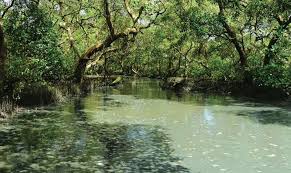MISHTI Scheme

- 03 Mar 2025
In News:
Gujarat has emerged as the national leader in mangrove afforestation, covering 19,020 hectares in just two years under the Centre’s ‘MISHTI’ scheme.
Key Highlights:
- The Mangrove Initiative for Shoreline Habitats and Tangible Incomes (MISHTI) scheme was launched in 2023 under the Union Budget for 2023-24.
- The scheme aims to restore degraded mangrove ecosystems and increase India’s mangrove cover, enhancing coastal resilience while fostering sustainable livelihoods for coastal communities.
- Implemented from 2023 to 2028, the scheme is funded through various channels, including the CAMPA Fund (Compensatory Afforestation Fund Management and Planning Authority), MGNREGS (Mahatma Gandhi National Rural Employment Guarantee Scheme), and other governmental and private funding sources.
- The initiative also supports India’s participation in the global Mangrove Alliance for Climate (MAC) launched at COP27.
Key Objectives of MISHTI
- Ecological Restoration: To restore degraded mangrove ecosystems and expand mangrove cover across coastal areas.
- Coastal Resilience: To strengthen coastal resilience against climate change, such as coastal erosion and rising sea levels.
- Livelihood Generation: To promote ecotourism, sustainable livelihoods, and fishing opportunities for coastal communities.
- Climate Change Mitigation: The scheme plays a crucial role in protecting shorelines from storms, supporting India's commitments under the Paris Agreement and the UN Sustainable Development Goals (SDGs).
Gujarat’s Role in MISHTI Scheme
- Gujarat has emerged as the national leader in mangrove afforestation under the MISHTI scheme, planting over 19,000 hectares of mangroves in just two years.
- The state is spearheading the mangrove expansion efforts, with its coastline covering diverse ecosystems such as mangroves, coral reefs, and seagrasses.
- Gujarat has surpassed the Central Government’s target of planting 540 sq. km of mangroves in five years, completing plantation across 190 sq. km in the initial two years of the scheme.
Mangrove Distribution in Gujarat
- Gujarat's mangrove cover is distributed strategically across different coastal regions:
- Kutch: 799 sq. km, including the Gulf of Kutch, home to the Marine National Park and Wildlife Sanctuary.
- Other Coastal Districts: Jamnagar, Rajkot (Morbi), Porbandar, DevbhoomiDwarka (236 sq. km).
- Central and Southern Belt: Includes Bhavnagar, Ahmedabad, Anand, Bharuch, Surat, Navsari, and Valsad, covering 134 sq. km, with important areas like the Gulf of Khambhat and Dumas-Ubhrat.
- Saurashtra Region: Amreli, Junagadh, and Gir-Somnath maintain 6 sq. km of mangrove cover.
Significance of Mangroves
- Erosion Prevention: Mangroves act as a natural barrier, protecting coastal regions from erosion caused by waves and storms.
- Biodiversity Support: They provide vital breeding grounds for fish and other marine species, supporting coastal livelihoods.
- Climate Resilience: Mangroves help mitigate the effects of climate change by shielding vulnerable coastal communities from cyclones, reducing salinity, and preserving agricultural lands.
Global and National Mangrove Status
- Global Mangrove Distribution: Mangroves are found in tropical and subtropical regions worldwide, providing critical ecosystem services.
- India’s Mangrove Cover: According to the India State of Forest Report 2023, India has a total mangrove cover of 4,991.68 km², which accounts for 15% of the country’s total geographical area. The MISHTI scheme plays a pivotal role in further expanding this cover.
